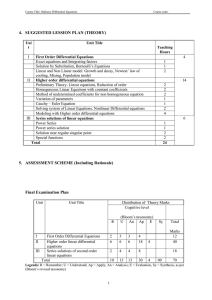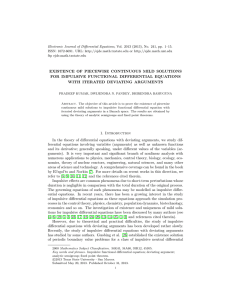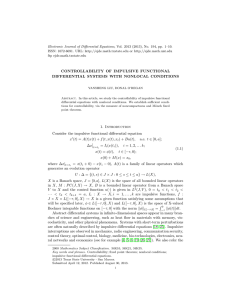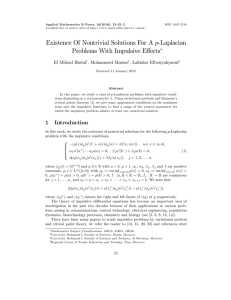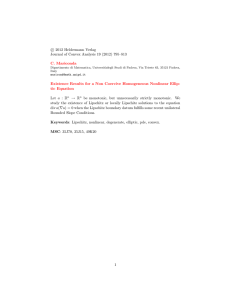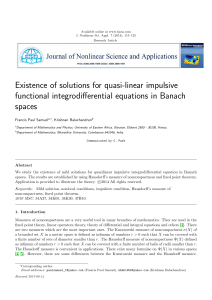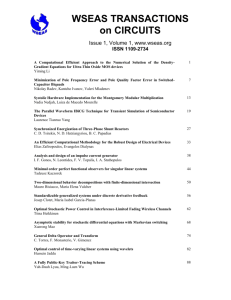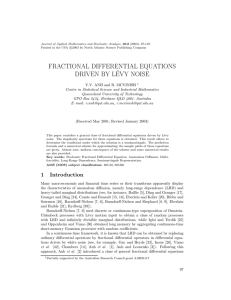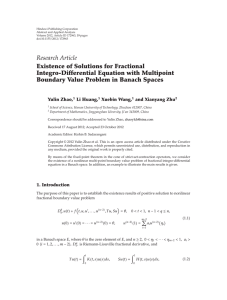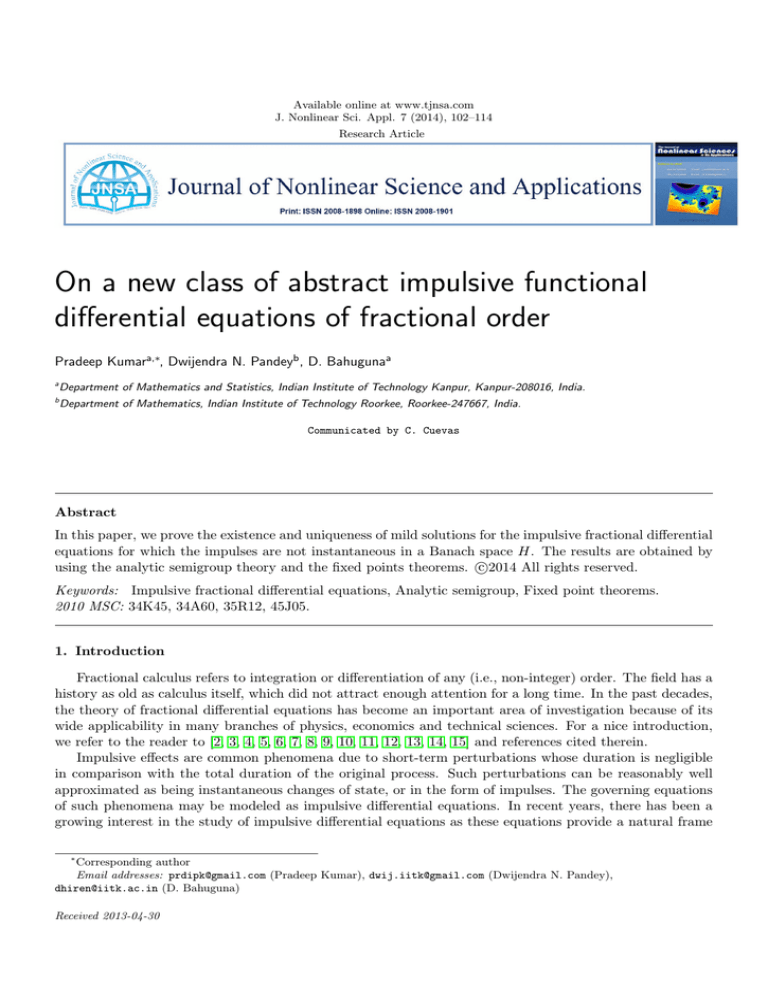
Available online at www.tjnsa.com
J. Nonlinear Sci. Appl. 7 (2014), 102–114
Research Article
On a new class of abstract impulsive functional
differential equations of fractional order
Pradeep Kumara,∗, Dwijendra N. Pandeyb , D. Bahugunaa
a
Department of Mathematics and Statistics, Indian Institute of Technology Kanpur, Kanpur-208016, India.
b
Department of Mathematics, Indian Institute of Technology Roorkee, Roorkee-247667, India.
Communicated by C. Cuevas
Abstract
In this paper, we prove the existence and uniqueness of mild solutions for the impulsive fractional differential
equations for which the impulses are not instantaneous in a Banach space H. The results are obtained by
c
using the analytic semigroup theory and the fixed points theorems. 2014
All rights reserved.
Keywords: Impulsive fractional differential equations, Analytic semigroup, Fixed point theorems.
2010 MSC: 34K45, 34A60, 35R12, 45J05.
1. Introduction
Fractional calculus refers to integration or differentiation of any (i.e., non-integer) order. The field has a
history as old as calculus itself, which did not attract enough attention for a long time. In the past decades,
the theory of fractional differential equations has become an important area of investigation because of its
wide applicability in many branches of physics, economics and technical sciences. For a nice introduction,
we refer to the reader to [2, 3, 4, 5, 6, 7, 8, 9, 10, 11, 12, 13, 14, 15] and references cited therein.
Impulsive effects are common phenomena due to short-term perturbations whose duration is negligible
in comparison with the total duration of the original process. Such perturbations can be reasonably well
approximated as being instantaneous changes of state, or in the form of impulses. The governing equations
of such phenomena may be modeled as impulsive differential equations. In recent years, there has been a
growing interest in the study of impulsive differential equations as these equations provide a natural frame
∗
Corresponding author
Email addresses: prdipk@gmail.com (Pradeep Kumar), dwij.iitk@gmail.com (Dwijendra N. Pandey),
dhiren@iitk.ac.in (D. Bahuguna)
Received 2013-04-30
P. Kumar, D. N. Pandey, D. Bahuguna, J. Nonlinear Sci. Appl. 7 (2014), 102–114
103
work for mathematical modelling of many real world phenomena, namely in the control theory, physics,
chemistry, population dynamics, biotechnology, economics and medical fields.
Due to the great development in the theory of fractional calculus and impulsive differential equations
as well as having wide applications in several fields. Recently, the study of fractional differential equations
with impulses has been studied by many authors (see [17, 18, 19, 20, 23, 24, 25, 26, 27, 28, 29, 30, 31, 32,
33, 34, 35, 36, 38]).
In [16], the authors introduced a new class of abstract differential equations for which the impulses are
not instantaneous and investigated the existence of mild and classical solutions for the following system:
u0 (t) = Au(t) + f (t, u(t)),
u(t) = gi (t, u(t)),
t ∈ (si , ti+1 ], i = 0, 1, · · · , N,
t ∈ (ti , si ],
i = 1, 2, · · · , N,
u(0) = u0 ,
(1.1)
(1.2)
(1.3)
where A is the infinitesimal generator of a C0 -semigroup of bounded linear operators, {S(t), t ≥ 0} on a
Banach space (H, k.k), the functions gi ∈ C((ti , si ] × H; H) for each i = 1, 2, · · · , N and f : [0, T0 ] × H → H
is suitable function.
Motivated by the work [16], In this article, we consider the following impulsive fractional differential
equations in a Banach space (H, k.k) for which impulses are not instantaneous:
C
Dtβ u(t) + Au(t) = f (t, u(t), u(g(t))), t ∈ (si , ti+1 ], i = 0, 1, · · · , N,
(1.4)
u(t) = hi (t, u(t)), t ∈ (ti , si ], i = 1, 2, · · · , N,
(1.5)
u(0) = u0 ∈ H,
(1.6)
where C Dtβ is the Caputo fractional derivative of order β, −A is the infinitesimal generator of an analytic
semigroup of bounded linear operators, {S(t), t ≥ 0} on a Banach space H, the impulses start suddenly at
the points ti and their action continues on the interval [ti , si ], 0 = t0 = s0 < t1 ≤ s1 ≤ t2 <, ..., < tN ≤
sN ≤< tN +1 = T0 , the functions hi ∈ C((ti , si ] × H; H) for each i = 1, 2, · · · , N , g : [0, T0 ] → [0, T0 ] and
f : [0, T0 ] × H × H → H are suitable functions.
The paper is organized as follows. In “Preliminaries and Assumptions” section, we provide some basic
definitions, notations, lemmas and proposition which are used throughout the paper. In “Existence of mild
solutions” section, we will prove some existence and uniqueness results concerning the PC-mild solutions.
In the last (i.e., In “Application”) section, we give an example to demonstrate the application of the main
results.
2. Preliminaries and assumptions
In this section, we will introduce some basic definitions, notations, lemmas and proposition which are
used throughout this paper.
It is assume that −A generates an analytic semigroup of bounded operators, denoted by S(t), t ≥ 0. It
is known that there exist constants M̃ ≥ 1 and ω ≥ 0 such that
kS(t)k ≤ M̃ eωt ,
t ≥ 0.
If necessary, we may assume without loss of generality that kS(t)k is uniformly bounded by M , i.e.,
kS(t)k ≤ M for t ≥ 0, and that 0 ∈ ρ(−A), implies −A is invertible. In this case, it is possible to define the
fractional power Aα for 0 ≤ α ≤ 1 as closed linear operator with domain D(Aα ) ⊆ H. Furthermore, D(Aα )
is dense in H and the expression
kxkα = kAα xk,
defines a norm on D(Aα ). Henceforth, we denote the space D(Aα ) by Hα endowed with the norm k · kα .
Also, for each α > 0, we define H−α = (Hα )∗ , the dual space of Hα , is a kxk−α = kA−α xk. For more details,
we refer to the reader to the book by Pazy [1, pp. 69].
P. Kumar, D. N. Pandey, D. Bahuguna, J. Nonlinear Sci. Appl. 7 (2014), 102–114
104
Lemma 2.1. [1, pp. 72,74,195-196] Suppose that −A is the infinitesimal generator of an analytic semigroup
S(t), t ≥ 0 with kS(t)k ≤ M for t ≥ 0 and 0 ∈ ρ(−A). Then we have the following:
(i) Hα is a Banach space for 0 ≤ α ≤ 1;
(ii) For any 0 < δ ≤ α implies D(Aα ) ⊂ D(Aδ ), the embedding Hα ,→ Hδ is continuous;
(iii) The operator Aα S(t) is bounded, i.e., there exists a constant N such that
kAα S(t)k ≤ N
and
kAα S(t)k ≤ Cα t−α
for each t > 0.
ei is
Lemma 2.2. [16, Lemma 1.1] A set B ⊆ PC(Hα ) is relatively compact in PC(Hα ) if and only if set B
relatively compact in C([ti , ti+1 ]; Hα ]), where PC(Hα ) is the space of piecewise continuous functions from
[0, T0 ] into Hα to be specified later.
Definition 2.3. [37, Def. 2.7] By the mild solution of the following system
C
Dtβ u(t) + Au(t) = h(t), t ∈ [t0 , T0 ],
(2.1)
u(t0 ) = u0 ,
(2.2)
we mean a continuous function u : [t0 , T0 ] → H which satisfies the following integral equation
Z t
u(t) = T(t − t0 )u0 +
(t − s)β−1 P(t − s)h(s)ds, t ∈ [t0 , T0 ],
t0
where
Z
∞
T(t) =
Z
β
ξβ (θ)S(t θ)dθ, P(t) = β
0
∞
θξβ (θ)S(tβ θ)dθ,
0
1 −1− β1
−1
ξβ (θ) = θ
ρβ (θ β ) ≥ 0,
β
∞
1X
Γ(nβ + 1)
ρβ (θ) =
(−1)n−1 θ−nβ−1
sin(nπβ),
π
n!
θ ∈ (0, ∞),
n=1
ξβ is a probability density function defined on (0, ∞), that is
Z ∞
ξβ (θ) ≥ 0, θ ∈ (0, ∞),
ξβ (θ) = 1,
0
and
Z
∞
γ
Z
θ ξβ (θ) =
0
0
∞
1
ρβ (θ)
θγβ
=
Γ(1 + γ)
, for any γ ∈ [0, 1].
Γ(1 + γβ)
Lemma 2.4. The operators T(.) and P(.) have the following properties:
(i). {T(t), t ≥ 0} and {P(t), t ≥ 0} are strongly continuous.
(ii). If {S(t), t > 0} is compact, then T(t) and P(t) are also compact operators for every t > 0.
(iii). For any fixed t ≥ 0, T(t) and P(t) are linear and bounded operators, i.e., for any x ∈ H,
kT(t)xk ≤ M kxk
and
kP(t)xk ≤
βM
kxk.
Γ(1 + β)
Remark 2.5. Since T(.) and P(.) are associated with the β, there are no analogue of the semigroup property,
i.e., T(t + s) 6= T(t)T(s), P(t + s) 6= P(t)P(s) for t, s > 0.
P. Kumar, D. N. Pandey, D. Bahuguna, J. Nonlinear Sci. Appl. 7 (2014), 102–114
105
3. Existence of mild solutions
In this section, we prove the existence of mild solutions for the impulsive system (1.4)-(1.6). To begin,
we use the following definition.
Definition 3.1. [16, Def. 2.1] A function u ∈ PC(H) is said to be a mild solution of the problem (1.4)-(1.6)
if u(0) = u0 , u(t) = hi (t, u(t)) for all t ∈ (ti , si ], for each i = 1, · · · , N and
Z
u(t)
=
∞
ξβ (θ)S(tβ θ)u0 dθ
Z tZ ∞
+ β
θξβ (θ)(t − s)β−1 S((t − s)β θ)f (s, u(s), u(g(s)))dθds,
0
0
0
for all t ∈ [0, t1 ] and
Z
u(t)
=
∞
ξβ (θ)S((t − si )β θ)hi (si , u(si ))dθ
Z tZ ∞
+ β
θξβ (θ)(t − s)β−1 S((t − s)β θ)f (s, u(s), u(g(s)))dθds,
0
si
0
for all t ∈ [si , ti+1 ], for each i = 1, · · · , N .
We define the set of functions as follows
+
PC(Hα ) = {u : [0, T0 ] → Hα : u(.) is continuous at t 6= ti , u(t−
k ) = u(tk ), u(tk )
exists for all i = 1, 2, · · · , N }.
PC(Hα ) is a Banach space endowed with the supremum norm
kukPC := sup ku(t)kα .
t∈I
Now, we define the functions u
ei ∈ C([ti , ti+1 ]; Hα ) given by
u
ei (t) =
u(t),
u(t+
i ),
for t ∈ (ti , ti+1 ],
for t = ti
Let B ⊆ PC(Hα ), we define
ei = {e
B
ui : u ∈ B}.
We shall use the following conditions on f and hi in its arguments:
(H1) Let W ⊂ Dom(f ) be an open subset of R+ × Hα × Hα , where 0 ≤ α < 1. For each (t, u, v) ∈ W , there
is a neighborhood V1 ⊂ W of (t, u, v), such that the nonlinear map f : R+ × Hα × Hα → H satisfies
the following condition,
kf (t, u, v) − f (t, u1 , v1 )k ≤ Lf {ku − u1 kα + kv − v1 kα }
for all (t, u, v), (t, u1 , v1 ) ∈ V1 , Lf = Lf (t, u, v, V1 ) > 0 is a constant.
(H2) Let g : [0, T0 ] → [0, T0 ] is continuous and satisfies the delay property g(t) ≤ t for t ∈ [0, T0 ].
P. Kumar, D. N. Pandey, D. Bahuguna, J. Nonlinear Sci. Appl. 7 (2014), 102–114
106
(H3) The functions hi : [ti , si ] × Hα → Hα are continuous and there are positive constants Lhi such that
khi (t, x) − hi (t, y)kα ≤ Lhi kx − ykα ,
for all x, y ∈ Hα , t ∈ [ti , si ] and each i = 0, 1, · · · , N.
(H4) For u, v ∈ Hα , the function f (., u, v) is strongly measurable on [0, T0 ] and f (t, ., .) ∈ C(Hα × Hα , H) ∈
1
for t ∈ [0, T0 ]. There exists a constant β1 ∈ [0, β) and mf ∈ L β1 ([0, T0 ], R+ ) such that kf (t, u, v)k ≤
mf (t) for all (t, u, v) ∈ [0, T0 ] × Hα × Hα .
Theorem 3.2. Suppose the assumptions (H1)-(H3) hold and
n
o
2Cα Lf Γ(2 − α)
β(1−α)
L = max M Lhi +
T0
: i = 1, · · · , N < 1.
(1 − α)Γ(1 + β(1 − α))
(3.1)
Then there exists a unique mild solution u ∈ PC(Hα ) of the problem (1.4)-(1.6).
Proof. Let us define a map Υ : PC(Hα ) → PC(Hα ), given by Υu(0) = u0 , Υu(t) = hi (t, u(t)) for t ∈
(ti , si ], i = 1, 2, · · · , N and
Z
Υu(t)
=
∞
ξβ (θ)S(tβ θ)u0 dθ
Z tZ ∞
+ β
θξβ (θ)(t − s)β−1 S((t − s)β θ)f (s, u(s), u(g(s)))dθds,
0
0
0
for all t ∈ [0, t1 ] and
Z
Υu(t)
=
∞
ξβ (θ)S((t − si )β θ)hi (si , u(si ))dθ
Z tZ ∞
θξβ (θ)(t − s)β−1 S((t − s)β θ)f (s, u(s), u(g(s)))dθds,
+ β
0
si
0
t ∈ [si , ti+1 ], i = 1, 2, · · · , N.
Clearly, Υ is well defined.
Next we show that Υ is contraction on PC(Hα ).
Let φ, ψ ∈ PC(Hα ), i ∈ {1, · · · , N } and t ∈ [si , ti+1 ], we have
Z
kΥφ(t) − Υψ(t)k
≤
∞
ξβ (θ)kS((t − si )β θ)k khi (si , φ(si )) − hi (si , ψ(si ))kα ds
0
Z tZ ∞
+ β
θξβ (θ)(t − s)β−1 kAα S((t − s)β θ)k
k
si
≤
≤
0
×kf (s, φ(s), φ(g(s))) − f (s, ψ(s), ψ(g(s)))kdθds
Z
Cα Lf βΓ(2 − α) t
M Lhi kφ − ψkPC +
(t − s)β(1−α)−1 [kφ(s) − ψ(s)kα
Γ(1 + β(1 − α)) si
+kφ(g(s)) − ψ(g(s))kα ]ds
2Cα Lf Γ(2 − α)
β(1−α)
]kφ − ψkPC .
[M Lhi +
T
(1 − α)Γ(1 + β(1 − α)) 0
(3.2)
P. Kumar, D. N. Pandey, D. Bahuguna, J. Nonlinear Sci. Appl. 7 (2014), 102–114
107
Thus, we have
kΥφ − ΥψkC([si ,ti+1 ];Hα ) ≤ [M Lhi +
2Cα Lf Γ(2 − α)
β(1−α)
T0
]kφ − ψkPC .
(1 − α)Γ(1 + β(1 − α))
(3.3)
Continuing in this fashion, we get
2Cα Lf Γ(2 − α)
β(1−α)
T
kφ − ψkPC ,
(1 − α)Γ(1 + β(1 − α)) 0
≤ Lhi kφ − ψkPC , i = 1, · · · , N.
kΥφ − ΥψkC([0,t1 ];Hα ) ≤
(3.4)
kΥφ − ΥψkC([si ,ti ];Hα )
(3.5)
Hence, from (3.3)-(3.5), we have
kΥφ − ΥψkPC ≤ Lkφ − ψkPC ,
i.e., Υ(.) is a contraction and there exists a unique mild solution of (1.4)-(1.6).
The next result concerning the existence and uniqueness of mild solutions for the impulsive system
(1.4)-(1.6) under the assumptions (H3) and (H4).
Theorem 3.3. Suppose the assumptions (H3) and (H4) hold. The semigroup {S(t); t ≥ 0} is compact, the
functions hi (., 0) are bounded, (3.1) holds and for each u0 ∈ Hα , let r > 1 and 0 < δ < 1 be such that
M ku0 kα + (1 + M ) maxi=1,··· ,N khi (., 0)kα ≤ (1 − δ)r,
n
β(1−α) o
T0
Γ(2−α)
≤ δr,
maxi=1,··· ,N Lhi (1 + M )kukPC + Cα Γ(1+β(1−α))
1−α ℵ
β(1−α)
Cα Γ(2−α) T0
Γ(1+β(1−α)) 1−α
sups∈[0,t1 ],v∈Br (0,PC(Hα )) kf (s, v(s), v(g(s)))k ≤ δr,
where ℵ = sups∈[si ,ti+1 ],v∈Br (0,PC(Hα )) kf (s, v(s), v(g(s)))k.
Then there exists a mild solution u ∈ PC(Hα ) of the impulsive problem (1.4)-(1.6).
Proof. Let
Υ=
N
X
i=0
Υ1i
+
N
X
Υ2i , where Υji : PC(Hα ) → PC(Hα ), i = 0, 1, · · · , N, j = 1, 2,
i=0
are given by
Υ1i u(t)
=
hi (t, u(t)),
R∞
0 ξβ (θ)S((t − si )β θ)hi (si , u(si ))ds,
0,
R∞
0
ξβ (θ)S(tβ θ)u0 dθ,
for t ∈ (ti , si ], i ≥ 1,
for t ∈ (si , ti+1 ], i ≥ 1,
for t ∈
/ [ti , ti+1 ], i ≥ 0,
for t ∈ [0, t1 ], i = 1,
Rt R∞
β si 0 θξβ (θ)(t − s)β−1 S((t − s)β θ)
×f (s, u(s), u(g(s)))dθds,
for t ∈ (si , ti+1 ], i ≥ 0,
Υ2i u(t) =
0,
for t ∈
/ (si , ti+1 ], i ≥ 0.
(3.6)
P. Kumar, D. N. Pandey, D. Bahuguna, J. Nonlinear Sci. Appl. 7 (2014), 102–114
β−1
1−β1
Also, let λ =
∈ (−1, 0), b =
β(1−α)−1
1−β1
> 0, M1 = kmf k
1
L β1 [0,T0 ]
108
, where β1 ∈ [0, β), 0 < α ≤ 1.
1
1−β1
It is easy to see that (t − s)β−1 ∈ L
[0, t], for t ∈ [0, T0 ].
By using Hölder inequality and (H4), for t ∈ [t1 , t2 ] ⊆ [0, T0 ], we get
Z t
1−β1
Z t
β−1
(t − s)λ ds
kmf k
|(t − s)
f (s, u(s), u(g(s)))|ds ≤
≤
1
L β1 [t1 ,t]
t1
t1
M1
(1+λ)(1−β1 )
T
.
(1 + λ)1−β1 0
Then, we have
Z tZ ∞
θξβ (θ)|(t − s)β−1 S((t − s)β θ)f (s, u(s), u(g(s)))|dθds
β
t1
0
∞
Z tZ
θξβ (θ)|(t − s)β−1 f (s, u(s), u(g(s)))|dθds
≤ Mβ
t1
≤
Mβ
Γ(1 + β)
0
t
Z
|(t − s)β−1 f (s, u(s), u(g(s)))|ds
t1
Z
1−β1
Mβ t
(t − s)λ ds
kmf k 1
≤
Γ(1 + β) t1
L β1 [t1 ,t]
βM M1
(1+λ)(1−β1 )
≤
T0
.
1−β
1
Γ(1 + β)(1 + λ)
(3.7)
Our aim is to prove that the map Υ is a condensing map from Br (0, PC(Hα )) into Br (0, PC(Hα )). For
this we have divided our proof into four steps.
Step 1. First we show that ΥBr (0, PC(Hα )) ⊂ Br (0, PC(Hα )), where
Br (0, PC(Hα )) = {u ∈ PC(Hα ) : kukα ≤ r},
for r > 0.
Let u ∈ Br (0, PC(Hα )). For i ≥ 1 and t ∈ (ti , ti+1 ], we get
kΥu(t)kα
≤
khi (t, u(t)) − hi (t, 0)kα + khi (t, 0)kα
Z ∞
+
ξβ (θ)kS((t − si )β θ)k khi (si , u(si )) − hi (si , 0)kα ds
Z0 ∞
+
ξβ (θ)kS((t − si )β θ)kkhi (si , 0)kα ds
0
Z tZ ∞
+ β
θξβ (θ)(t − s)β−1 kAα S((t − s)β θ)k kf (s, u(s), u(g(s)))kdθds
si
≤
0
Lhi ku(t)k + khi (t, 0)kα + M Lhi ku(t)k + M khi (t, 0)kα
Z t
(t − s)β(1−α)−1
sup
kf (s, v(s), v(g(s)))kds
+ Cα β
Z
×
si
∞
θ1−α ξβ (θ)dθ
s∈[si ,ti+1 ],v∈Br (0,PC(Hα ))
0
≤
Lhi (1 + M )kukPC + (1 + M )khi (t, 0)kα
β(1−α)
Γ(2 − α)
T0
+ Cα
Γ(1 + β(1 − α)) 1 − α
sup
s∈[si ,ti+1 ],v∈Br (0,PC(Hα ))
kf (s, v(s), v(g(s)))k
(3.8)
P. Kumar, D. N. Pandey, D. Bahuguna, J. Nonlinear Sci. Appl. 7 (2014), 102–114
109
which implies that kΥukα ≤ r for all i ≥ 1. Similarly, for each t ∈ [0, t1 ], we find that
Z ∞
ξβ (θ)kS(tβ θ)k kAα u0 kdθ
kΥu(t)kα
≤
0
Z tZ ∞
+ β
θξβ (θ)(t − s)β−1 kAα S((t − s)β θ)kkf (s, u(s), u(g(s)))kdθds
0
0
β(1−α)
Cα Γ(2 − α) T0
M ku0 kα +
Γ(1 + β(1 − α)) 1 − α
≤
sup
kf (s, v(s), v(g(s)))k
s∈[0,t1 ],v∈Br (0,PC(Hα ))
from which we get kΥukα ≤ P
r and Υ has values in Br (0, PC(Hα )).
1
Step 2. The map Υ1 = N
i=0 Υi is a contraction on Br (0, PC(Hα )).
Let t ∈ (ti , ti+1 ] and u, v ∈ Br (0, PC(Hα )), i = 1, · · · , N , we have
kΥ1i u(t) − Υ1i v(t)kPC(Hα ) ≤ (1 + M )Lhi ku − vkC((ti ,ti+1 ],Hα ) ,
P
PN
1
1
which implies that k N
i=0 Υi u −
i=0 Υi vkPC ≤ Lku − vkPC , i.e., Υ1 is a contraction on Br (0, PC(Hα )).
Let Υ2i Br (0, PC(Hα ))(t) = {Υ2i u(t) : uS∈ Br (0, PC(Hα ))}.
Step 3. Next, we prove that the set Υ2i Br (0, PC(Hα ))(t) is relatively compact in Hα .
Let t ∈ (si , ti+1 ], for i = 0, 1, · · · , N, then for each ∈ (si , s) and for each δ > 0, we define an operator
(Υ2i ),δ on Br (0, PC(Hα )) by
Z t−
n Z ∞
o
β−1
2
β
β
θξβ (θ)S((t − s)β θ − β δ)dθ
(t − s)
((Υi ),δ u)(t)
=
S( δ)
δ
si
× f (s, u(s), u(g(s)))ds,
where u ∈ Br (0, PC(Hα )). The set
(Br ),δ (0, PC(Hα ))(t) = {((Υ2i ),δ u)(t) : u ∈ Br (0, PC(Hα ))}
is relatively compact in Hα . Since the operator S(β δ), is compact.
Also, for each u ∈ Br (0, PC(Hα )), we have
k(Υ2i u)(t) − ((Υ2i ),δ u)(t)kα
Z tZ δ
θξβ (θ)(t − s)β−1 S((t − s)β θ)f (s, u(s), u(g(s)))dθds
βk
≤
si
Z tZ
0
∞
θξβ (θ)(t − s)β−1 S((t − s)β θ)f (s, u(s), u(g(s)))dθds
+
si δ
t− Z ∞
Z
−
si
Z tZ
≤
δ
δ
θξβ (θ)(t − s)β−1 kAα S((t − s)β θ)kkf (s, u(s), u(g(s)))kdθds
β
si
t
Z
θξβ (θ)(t − s)β−1 S((t − s)β θ)f (s, u(s), u(g(s)))dθdskα
0
Z
∞
θξβ (θ)(t − s)β−1 kAα S((t − s)β θ)kkf (s, u(s), u(g(s)))kdθds
+ β
t−
≤
Cα β
Z
δ
t
b
(t − s) ds
1−β1
si
+Cα β
≤
Z
t
Z
kmf k
1
L β1
[si ,t]
1−β1
kmf k
(t − s)b ds
t−
(1+b)(1−β1 )
βM1 Cα T0
(1 + b)(1−β1 )
δ
θξβ (θ)dθ +
0
θ1−α ξβ (θ)dθ
0
Z
1
L β1
Z
δ
[t−,t]
∞
θ1−α ξβ (θ)dθ
0
βM1 Cα Γ(2 − α)
(1+b)(1−β1 ) .
Γ(1 + β(1 − α))(1 + b)(1−β1 )
Therefore, there exists relatively compact sets arbitrarily close to the set
P. Kumar, D. N. Pandey, D. Bahuguna, J. Nonlinear Sci. Appl. 7 (2014), 102–114
110
S
Υ2i Br (0, PC(Hα ))(t). Thus, the set Υ2i Br (0, PC(Hα ))(t) is relatively compact in Hα .
Step 4. In this step, our aim is to prove that the set of functions
[Υ2i Br (0,^
PC(Hα ))]i , i = 0, 1, · · · , N is an equicontinuous subset of C([ti , ti+1 ], Hα ).
Let t1 , t2 ∈ [si , ti+1 ], t1 < t2 and u ∈ Br (0, PC(Hα )), we get
S
k(Υ2i u)(t2 ) − (Υ2i u)(t1 )kα
Z t2 Z ∞
θξβ (θ)(t2 − s)β−1 kAα S((t2 − s)β θ)kkf (s, u(s), u(g(s)))kdθds
β
≤
t1
t1
Z
0
Z
+ β
si
Z
t1
+ β
si
∞
θξβ (θ)[(t2 − s)β−1 − (t1 − s)β−1 ]kAα S((t2 − s)β θ)k
0
×kf (s, u(s), u(g(s)))kdθds
Z ∞
θξβ (θ)(t1 − s)β−1 kAα [S((t2 − s)β θ) − S((t1 − s)β θ)]k
0
× kf (s, u(s), u(g(s)))kdθds.
(3.9)
For the first term on the right hand side of (3.9), we have
Z
t2
Z
∞
θξβ (θ)(t2 − s)β−1 kAα S((t2 − s)β θ)kkf (s, u(s), u(g(s)))kdθds
β
t1
0
Z
1−β1
βCα M1 Γ(2 − α) t2
≤
(t2 − s)b ds
Γ(1 + β(1 − α))
t1
βCα M1 Γ(2 − α)
(t2 − t1 )(1+b)(1−β1 )
≤
(1−β
)
1
(1 + b)
Γ(1 + β(1 − α))
(3.10)
For the second term on the right hand side of (3.9), we have
Z
t1
Z
β
si
≤
≤
≤
≤
∞
θξβ (θ)[(t2 − s)β−1 − (t1 − s)β−1 ]kAα S((t2 − s)β θ)k
0
×kf (s, u(s), u(g(s)))kdθds
Z
1−β1
1
βN M1 t1
[(t2 − s)β−1 − (t1 − s)β−1 ] 1−β1 ds
Γ(1 + β) si
Z
1−β1
βN M1 t1
[(t1 − s)λ − (t2 − s)λ ]ds
Γ(1 + β) si
1−β1
βN M1
1+λ
1+λ
1+λ
(t
−
t
)
−
((t
−
s
)
−
(t
−
s
)
)
2
1
2
i
1
i
Γ(1 + β)(1 + λ)1−β1
βN M1
(t2 − t1 )(1+λ)(1−β1 )
Γ(1 + β)(1 + λ)1−β1
(3.11)
For t1 = si , it is easy to see that the third term on the right hand side of (3.9) will be zero. For t1 > si
and > 0 be sufficiently small, we have
P. Kumar, D. N. Pandey, D. Bahuguna, J. Nonlinear Sci. Appl. 7 (2014), 102–114
Z
t1 − Z ∞
β
si
111
θξβ (θ)(t1 − s)β−1 kAα [S((t2 − s)β θ) − S((t1 − s)β θ)]k
0
Z
×kf (s, u(s), u(g(s)))kdθds
Z ∞
θξβ (θ)(t1 − s)β−1 kAα [S((t2 − s)β θ) − S((t1 − s)β θ)]k
t1
+β
t1 −
0
×kf (s, u(s), u(g(s)))kdθds
M1 (t1+λ
− 1+λ )(1−β1 )
1
Γ(1 + β)(1 + λ)1−β1
≤
+
sup
kAα [S((t2 − s)β θ) − S((t1 − s)β θ)]k
s∈[si ,t1 −]
2βN M1
(1+λ)(1−β1 )
Γ(1 + β)(1 + λ)1−β1
(3.12)
Thus, from (3.10)-(3.12) we see that kΥ2i u(t2 ) − Υ2i u(t1 )kα tends to zero as t2 → t1 for any u ∈
Br (0, PC(Hα )), which means that [Υ2i Br (0,^
PC(Hα ))]i is equicontinuous.
Lemma (2.2) and the above steps shows that Υ1 is a contraction, Υ2 is completely continuous and
Υ = Υ1 + Υ2 is a condensing map on Br (0, PC(Hα )). Then Krasnoselskii’s fixed point theorem ensures that
Υ has a fixed point, which gives rise to a mild solution.
4. Application
Consider the following impulsive system of fractional partial differential equations
C
Dtβ u(t, x)
=
u(t, 0) =
u(0, x) =
u(t, x) =
N
[
∂2u
+
F
(t,
x,
u(t,
x),
u(g(t),
x)),
(t,
x)
∈
[si , ti+1 ] × [0, π],
∂x2
i=1
u(t, π) = 0,
t ∈ [0, T0 ]
u0 (x),
x ∈ [0, π],
Hi (t, u(t, x)),
x ∈ [0, π], t ∈ (ti , si ]
(4.1)
where 0 = t0 = s0 < t1 ≤ s1 < · · · < tN ≤ sN < tN +1 = T0 are fixed real numbers, u0 ∈ H, F ∈
([0, T0 ] × R × R, R) and Hi ∈ C((ti , si ] × R, R) for all i = 1, · · · , N .
∂2
(A1). Let H = L2 ([0, π]) and Au = − ∂x
2 u with
D(A) = {u ∈ H :
∂u ∂ 2 u
,
∈ H, u(0) = u(π) = 0} = H 2 (0, π) ∩ H01 (0, π),
∂x ∂x2
clearly, the operator A is the infinitesimal generator of a compact analytic semigroup S(t). Taking α = 1/2,
we have D(A1/2 ) is Banach space endowed with norm
kuk1/2 = kA1/2 uk, u ∈ D(A1/2 ).
We can formulate the impulsive system (4.1) in the abstract form (1.4)-(1.6), where u(t) = u(t, .), i.e.,
u(t)(x) = u(t, x) and the functions f : [0, T0 ] × H1/2 × H1/2 → H and hi : (ti , si ] × H1/2 → H are given by
f (t, u(t), u(g(t)))(x) = F (t, x, u(t, x), u(g(t), x)),
hi (t, u(t))(x) = Hi (t, u(t, x)).
Case 1. Define
(A2).
e−t {|u(t, x)| + |u(g(t), x)|]}
, γ > −1,
(γ + et ){1 + |u(t, x)| + |u(g(t), x)|]}
t ∈ [0, T0 ], u ∈ H1/2 , x ∈ (0, π).
f (t, u(t), u(g(t)))(x) =
P. Kumar, D. N. Pandey, D. Bahuguna, J. Nonlinear Sci. Appl. 7 (2014), 102–114
112
Clearly, f : [0, T0 ] × H1/2 × H1/2 → H is continuous function, such that
kf (t, u1 , v1 ) − f (t, u2 , v2 )k ≤ Lf {ku1 − u2 k1/2 + kv1 − v2 k1/2 },
with Lf =
1
γ+1 .
cos t|u(t, x)|
, t ∈ (ti , si ], i = 1, 2, · · · , N,
2(1 + |u(t, x)|)
u ∈ H1/2 , x ∈ (0, π).
(A3).
hi (t, u(t))(x) =
(4.2)
Clearly, hi : (ti , si ] × H1/2 → H are continuous functions, such that
khi (t, u1 ) − f (t, u2 )k ≤ Lhi ku1 − u2 k1/2 ,
with Lhi = 21 .
(A4). We can choose g as follows
(i). g(t) = kt
t ∈ [0, T0 ], k ∈ [0, 1],
for
(ii). g(t) = k sin t for t ∈ [0, π/2], k ∈ [0, 1].
Hence, (A1)+(A2)+(A3)+(A4) implies that the assumptions in Theorem (3.2) are satisfied. For more
details, we refer to [18].
Case 2. Define
(A5).
e−t (sin(u(t, x)) + cos(u(g(t), x)))
+ e−t ,
(1 + t)(et + e−t )
t ∈ [0, t1 ] ∪ (s1 , t2 ] · · · ∪ (sN , T0 ], u ∈ H, x ∈ (0, π).
f (t, u(t), u(g(t)))(x) =
Satisfies,
kf (t, u)k ≤
2e−t
+ e−t = mf (t), with mf (t) ∈ L∞ ([0, T0 ], R+ ).
et + e−t
Hence, (A1)+(A3)+(A4)+(A5) implies that the assumptions in Theorem (3.3) are also satisfied.
System (4.1) has a mild solution u ∈ PC(H) if u(.) is a mild solution of the associated abstract form
(1.4)-(1.6).
The following theorem follows immediately from Theorem 3.2 and Theorem 3.3.
Theorem 4.1. If any of the following assumption is hold. Then there exists a mild solution u ∈ PC(H) of
(4.1)
(i). The functions F and Hi are Lipschitz with Lipschitz constant LF and LHi respectively and max{M LHi +
β(1−α)
2Cα LF Γ(2−α)
: i = 1, · · · , N } < 1.
(1−α)Γ(1+β(1−α)) T0
(ii). The functions Hi (.) are Lipschitz with Lipschitz constant LHi , the function F (.) is bounded with LHi <
1 for all i = 1, · · · , N .
P. Kumar, D. N. Pandey, D. Bahuguna, J. Nonlinear Sci. Appl. 7 (2014), 102–114
113
Acknowledgement
We highly appreciate the valuable comments and suggestions of the referees’ on our manuscript which
helped to considerably improve the quality of the manuscript. The third author would like to acknowledge
the financial aid from the Department of Science and Technology, New Delhi, under its research project
SR/S4/MS:796/12.
References
[1] A. Pazy, Semigroups of Linear Operators and Applications to Partial Differential Equations, Springer-Verlag,
1983.
[2] I. Podlubny, Fractional differential equations, Academic Press; 1999.
[3] V. Lakshmikantham, S. Leela and J. Devi Vasundhara, Theory of fractional dynamic systems, Cambridge Scientific
Publishers; 2009.
[4] K. Diethelm, The analysis of fractional differential equations. Lecture notes in mathematics, Berlin Heidelberg:
Springer-Verlag; 2010.
[5] A. Anatoly Kilbas, H. M. Srivastava and J. J. Trujillo, Theory and applications of fractional differential equations,
B.V.: Elsevier Science; 2006.
[6] KS. Miller and B. Ross, An introduction to the fractional calculus and differential equations, John Wiley; 1993.
[7] N. Rong Wang, De-H. Chen and Ti-J. Xiao, Abstract fractional Cauchy problems with almost sectorial operators,
J. Differential Equations 252 (2012), 202-235.
[8] F. Mainardi, On the initial value problem for the fractional diffusion-wave equation, Ser. Adv. Math. Appl. Sci.
23 (1994), 246-251.
[9] F. Mainardi, The time fractional diffusion-wave equation, Radiophys. and Quantum Electronics 38 (1995), 13-24.
[10] F. Mainardi, A. Mura and G. Pagnini, The functions of the Wright type in fractional calculus, Lecture Notes of
Seminario Interdisciplinare di Mathematica 9 (2010), 111-128 .
[11] F. Mainardi and R. Gorenflo, On Mittag-Leffler-type functions in fractional evolution processes. Higher transcendental functions and their applications, J. Comput. Appl. Math. 118 (2000), 283-299.
[12] F. Mainardi, A. Mura and G. Pagnini, The M-Wright function in time-fractional diffusion processes: a tutorial
survey, Int. J. Differ. Equ. (2010), 1-29.
λ
[13] H. Pollard, The representation of e−x as a Laplace integral, Bull. Amer. Math. Soc. 52 (1946), 908-910.
[14] M. El-Borai, Some probability densities and fundamental solutions of fractional evolution equations, Chaos Solitons
Fractals. 14 (2002), 433-440.
[15] M. W. Michalski, Derivatives of non-integer order and their applications. Dissertationes mathematicae, Inst Math
Polish Acad Sci; 1993.
[16] E. Hernández and D. O’Regan, On a new class of abstract impulsive differential equations, Proc. Amer. Math.
Soc. 141 (2013), 1641-1649.
[17] M. Benchohra, J. Henderson and S. Ntouyas, Impulsive differential equations and inclusions, Contemporary
Mathematics and Its Applications, Hindawi Publishing Corporation; New York, 2006.
[18] J. Wang, M. Fec̆kan and Y. Zhou, On the new concept of solutions and existence results for impulsive fractional
evolution equations, Dyn. Partial Differ. Equ. 8 (2011), 345-361.
[19] J. Wang, X. Li and W. Wei, On the natural solution of an impulsive fractional differential equation of order
q ∈ (1, 2), Commun. Nonlinear Sci. Numer. Simul. 17 (2012), 4384-4394.
[20] X. Li, F. Chen and Xuezhu Li, Generalized anti-periodic boundary value problems of impulsive fractional differential equations, Commun. Nonlinear Sci. Numer. Simul. 18 (2013), 28-41.
[21] V. Kavitha, M. Mallika Arjunan and C. Ravichandran, Existence results for impulsive systems with nonlocal
conditions in Banach spaces. J. Nonlinear Sci. Appl. 4 (2011), 138-151.
[22] T. Gunasekar, F. P. Samuel and M. Mallika Arjunan, Existence results for impulsive neutral functional integrodifferential equation with infinite delay. J. Nonlinear Sci. Appl. 6 (2013), 234-243.
[23] A. Anguraj, M. Mallika Arjunan and E. M. Hernández, Existence results for an impulsive neutral functional
differential equation with state-dependent delay, Appl.Anal. 86 (2007), 861-872.
[24] C. Cuevas, G. N’Guérékata and M. Rabelo, Mild solutions for impulsive neutral functional differential equations
with state- dependent delay, Semigroup Forum, vol. 80 (2010), 375-390.
[25] E. Hernández, A. Anguraj and M. Mallika Arjunan, Existence results for an impulsive second order differential
equation with state-dependent delay, Dyn. Contin. Discrete Impuls. Syst. Ser. A Math. Anal. 17 (2010), 287-301.
[26] M. Maliika Arjunan and V. Kavitha, Existence results for impulsive neutral functional differential equation with
state-dependent delay, Electorn. J. Qual. Theory Differ. Equ. (2009), 1-13.
[27] Y. K. Chang, A. Anguraj and M. Mallika Arjunan, Existence results for impulsive neutral functional differential
equations with infinite delay, Nonlinear Anal. Hybrid Syst. 2 (2008), 209-218.
[28] Y. K. Chang and J. Juan Nieto, Existence of solutions for impulsive neutral integro-differential inclusions with
nonlocal initial conditions via fractional operators, Funct. Anal. Optim. 30 (2009), 227-244.
P. Kumar, D. N. Pandey, D. Bahuguna, J. Nonlinear Sci. Appl. 7 (2014), 102–114
114
[29] W. Ding and Yu. Wang, New result for a class of impulsive differential equation with integral boundary conditions,
Commun. Nonlinear Sci. Numer. Simul. 18 (2013), 1095-1105.
[30] Ch. Bai, Existence result for boundary value problem of nonlinear impulsive fractional differential equation at
resonance, J. Appl. Math. Comput. 39 (2012), 421-443.
[31] M. Gisle Mophou, Existence and uniqueness of mild solutions to impulsive fractional differential equations, Nonlinear Anal. 72 (2010), 1604-1615.
[32] Y. Liu, Existence of solutions for impulsive differential models on half lines involving Caputo fractional derivatives,
Commun. Nonlinear Sci. Numer. Simul. 18 (2013), 2604-2625.
[33] G. Wang, B. Ahmad and L. Zhang, On impulsive boundary value problems of fractional differential equations
with irregular boundary conditions, Abstr. Appl. Anal. (2012), 1-15.
[34] A. Debbouche and D. Baleanu, Controllability of fractional evolution nonlocal impulsive quasilinear delay integrodifferential systems, Comput. Math. Appl. 62 (2011), 1442-1450.
[35] N. Marcos Rabelo, M. Henrique and G. Siracusa, Existence of integro-differential solutions for a class of abstract
partial impulsive differential equations, J. Inequal. Appl. (2011), 1-19.
[36] D. Zhang, Multiple solutions of nonlinear impulsive differential equations with Dirichlet boundary conditions via
variational method, Results Math. 63 (2013), 611-628.
[37] J. Wang and Y. Zhou, Existence and controllability results for fractional semilinear differential inclusions, Nonlinear Anal. Real World Appl. 12 (2011), 3642-3653.
[38] M. Benchohra, J. Henderson and S. K. Ntouyas, Existence results for impulsive semilinear neutral functional
differential equations in Banach spaces, Differential Equations Math. Phys. 25 (2002), 105-120.


